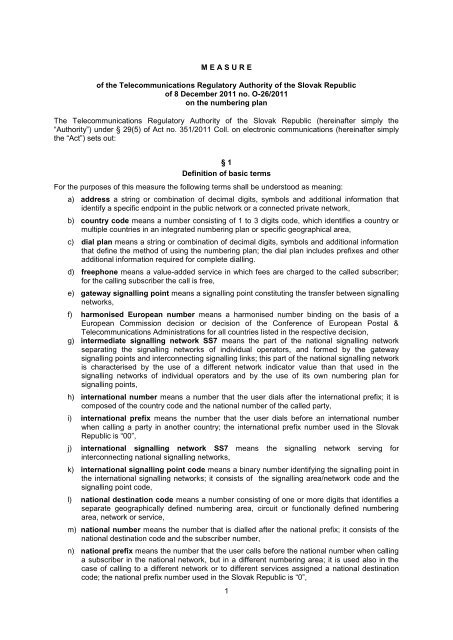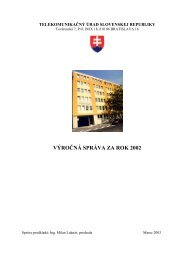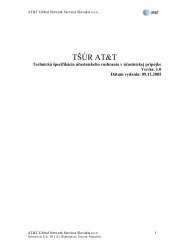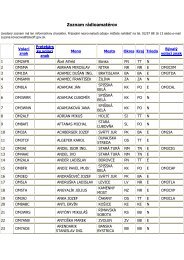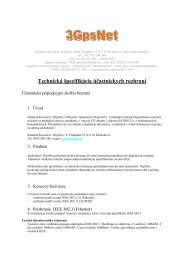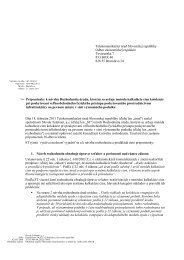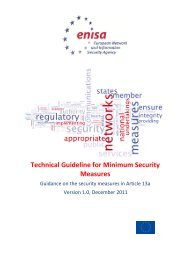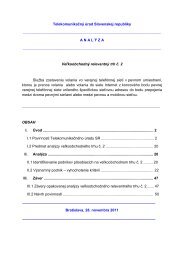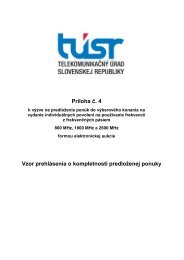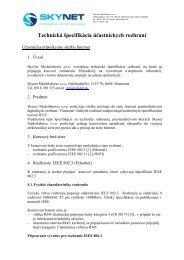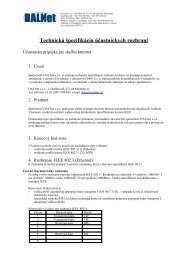Measure of the Telecommunications Regulatory Authority of the ...
Measure of the Telecommunications Regulatory Authority of the ...
Measure of the Telecommunications Regulatory Authority of the ...
Create successful ePaper yourself
Turn your PDF publications into a flip-book with our unique Google optimized e-Paper software.
M E A S U R E<br />
<strong>of</strong> <strong>the</strong> <strong>Telecommunications</strong> <strong>Regulatory</strong> <strong>Authority</strong> <strong>of</strong> <strong>the</strong> Slovak Republic<br />
<strong>of</strong> 8 December 2011 no. O-26/2011<br />
on <strong>the</strong> numbering plan<br />
The <strong>Telecommunications</strong> <strong>Regulatory</strong> <strong>Authority</strong> <strong>of</strong> <strong>the</strong> Slovak Republic (hereinafter simply <strong>the</strong><br />
“<strong>Authority</strong>”) under § 29(5) <strong>of</strong> Act no. 351/2011 Coll. on electronic communications (hereinafter simply<br />
<strong>the</strong> “Act”) sets out:<br />
§ 1<br />
Definition <strong>of</strong> basic terms<br />
For <strong>the</strong> purposes <strong>of</strong> this measure <strong>the</strong> following terms shall be understood as meaning:<br />
a) address a string or combination <strong>of</strong> decimal digits, symbols and additional information that<br />
identify a specific endpoint in <strong>the</strong> public network or a connected private network,<br />
b) country code means a number consisting <strong>of</strong> 1 to 3 digits code, which identifies a country or<br />
multiple countries in an integrated numbering plan or specific geographical area,<br />
c) dial plan means a string or combination <strong>of</strong> decimal digits, symbols and additional information<br />
that define <strong>the</strong> method <strong>of</strong> using <strong>the</strong> numbering plan; <strong>the</strong> dial plan includes prefixes and o<strong>the</strong>r<br />
additional information required for complete dialling.<br />
d) freephone means a value-added service in which fees are charged to <strong>the</strong> called subscriber;<br />
for <strong>the</strong> calling subscriber <strong>the</strong> call is free,<br />
e) gateway signalling point means a signalling point constituting <strong>the</strong> transfer between signalling<br />
networks,<br />
f) harmonised European number means a harmonised number binding on <strong>the</strong> basis <strong>of</strong> a<br />
European Commission decision or decision <strong>of</strong> <strong>the</strong> Conference <strong>of</strong> European Postal &<br />
<strong>Telecommunications</strong> Administrations for all countries listed in <strong>the</strong> respective decision,<br />
g) intermediate signalling network SS7 means <strong>the</strong> part <strong>of</strong> <strong>the</strong> national signalling network<br />
separating <strong>the</strong> signalling networks <strong>of</strong> individual operators, and formed by <strong>the</strong> gateway<br />
signalling points and interconnecting signalling links; this part <strong>of</strong> <strong>the</strong> national signalling network<br />
is characterised by <strong>the</strong> use <strong>of</strong> a different network indicator value than that used in <strong>the</strong><br />
signalling networks <strong>of</strong> individual operators and by <strong>the</strong> use <strong>of</strong> its own numbering plan for<br />
signalling points,<br />
h) international number means a number that <strong>the</strong> user dials after <strong>the</strong> international prefix; it is<br />
composed <strong>of</strong> <strong>the</strong> country code and <strong>the</strong> national number <strong>of</strong> <strong>the</strong> called party,<br />
i) international prefix means <strong>the</strong> number that <strong>the</strong> user dials before an international number<br />
when calling a party in ano<strong>the</strong>r country; <strong>the</strong> international prefix number used in <strong>the</strong> Slovak<br />
Republic is “00”,<br />
j) international signalling network SS7 means <strong>the</strong> signalling network serving for<br />
interconnecting national signalling networks,<br />
k) international signalling point code means a binary number identifying <strong>the</strong> signalling point in<br />
<strong>the</strong> international signalling networks; it consists <strong>of</strong> <strong>the</strong> signalling area/network code and <strong>the</strong><br />
signalling point code,<br />
l) national destination code means a number consisting <strong>of</strong> one or more digits that identifies a<br />
separate geographically defined numbering area, circuit or functionally defined numbering<br />
area, network or service,<br />
m) national number means <strong>the</strong> number that is dialled after <strong>the</strong> national prefix; it consists <strong>of</strong> <strong>the</strong><br />
national destination code and <strong>the</strong> subscriber number,<br />
n) national prefix means <strong>the</strong> number that <strong>the</strong> user calls before <strong>the</strong> national number when calling<br />
a subscriber in <strong>the</strong> national network, but in a different numbering area; it is used also in <strong>the</strong><br />
case <strong>of</strong> calling to a different network or to different services assigned a national destination<br />
code; <strong>the</strong> national prefix number used in <strong>the</strong> Slovak Republic is “0”,<br />
1
o) national signalling network SS7 means <strong>the</strong> signalling network in one state (country),<br />
comprising signalling networks <strong>of</strong> all operators and intermediate signalling networks,<br />
p) network destination code means an optional code field in <strong>the</strong> E.164 numbering plan that<br />
identifies <strong>the</strong> destination network serving <strong>the</strong> called party. In <strong>the</strong> framework <strong>of</strong> <strong>the</strong> national<br />
destination code, <strong>the</strong> NDC, it serves for selecting <strong>the</strong> destination network. This can be one<br />
decimal digit or a combination <strong>of</strong> decimal digits that does not contain any prefix,<br />
q) network indicator means <strong>the</strong> part <strong>of</strong> <strong>the</strong> subservice field in <strong>the</strong> service information octet,<br />
which is used for distinguishing messages belonging to <strong>the</strong> individual signalling networks:<br />
international, national and intermediate,<br />
r) network routing number means a number that is derived and used by a network for routing<br />
calls to a ported number,<br />
s) number means a string <strong>of</strong> decimal digits that uniquely identifies <strong>the</strong> endpoint <strong>of</strong> <strong>the</strong> public<br />
network; a number contains <strong>the</strong> information needed for routing calls to this endpoint,<br />
t) numbering plan means <strong>the</strong> specification <strong>of</strong> <strong>the</strong> format and structure <strong>of</strong> numbers used in this<br />
plan; typically it consists <strong>of</strong> decimal digits divided into groups for <strong>the</strong> purpose <strong>of</strong> identifying<br />
specific elements used for identification, routing and call charging; <strong>the</strong> numbering plan does<br />
not include prefixes and o<strong>the</strong>r additional information required for complete dialling,<br />
u) open numbering plan means a hierarchical structure <strong>of</strong> numbering in which subscribers are<br />
divided into numbering areas identified by a national destination code; in <strong>the</strong> case <strong>of</strong> calls<br />
between subscribers <strong>of</strong> <strong>the</strong> same numbering area it is sufficient to dial just <strong>the</strong> subscriber<br />
number; in <strong>the</strong> case <strong>of</strong> calls between parties from different numbering areas it is necessary to<br />
dial <strong>the</strong> national prefix, <strong>the</strong> trunk code and <strong>the</strong> subscriber number,<br />
v) personal communications service means a service capable <strong>of</strong> reaching a service<br />
subscriber by means <strong>of</strong> an assigned number, where <strong>the</strong> call can be routed to different<br />
destinations according to <strong>the</strong> service subscriber’s assignment,<br />
w) prefix means a number consisting <strong>of</strong> one or more digits making it possible to distinguish<br />
various types <strong>of</strong> number formats, networks or services,<br />
x) premium rate service means a value-added service provided at an increased tariff,<br />
y) primary area means <strong>the</strong> entire territory <strong>of</strong> <strong>the</strong> Slovak Republic, which is defined by <strong>the</strong><br />
national destination code,<br />
z) service destination code means a number that identifies a requested service available<br />
through <strong>the</strong> public network; it consists <strong>of</strong> multiple digits,<br />
aa) shared cost service means a value-added service in which <strong>the</strong> fees for <strong>the</strong> call are charged<br />
to both <strong>the</strong> calling and called part in a fixed ratio,<br />
ab) signalling area/network code means a binary number identifying <strong>the</strong> world geographic zone<br />
and geographic area or network in that specific zone,<br />
ac) signalling link means a transmission device consisting <strong>of</strong> a signalling data link and its control<br />
functions, which is used for secure transmission <strong>of</strong> signalling messages,<br />
ad) signalling message means a set <strong>of</strong> signalling information pertaining to <strong>the</strong> call, <strong>the</strong> control<br />
action, which is transmitted as an integral whole,<br />
ae) signalling network SS7 means <strong>the</strong> network used for signalling one or more users using SS7,<br />
consists <strong>of</strong> signalling points and interconnecting signalling links,<br />
af) signalling point code means a binary number identifying <strong>the</strong> signalling point in <strong>the</strong> signalling<br />
network; it may, depending on its location in <strong>the</strong> routing message header, be used as <strong>the</strong><br />
originating point code or <strong>the</strong> destination point code,<br />
ag) signalling point means a physical point or node <strong>of</strong> <strong>the</strong> signalling network that transmits and<br />
receives signalling messages or transmits signalling messages from one signalling link to<br />
ano<strong>the</strong>r or both. A node <strong>of</strong> <strong>the</strong> signalling network may in specific cases be divided in terms <strong>of</strong><br />
<strong>the</strong> SS7 function into logically separate units; for one node <strong>the</strong>re may be defined more than<br />
one signalling point,<br />
ah) signalling system no. 7 means <strong>the</strong> standard signalling system in common channel signalling,<br />
2
ai) signalling transfer point means a signalling point with <strong>the</strong> function <strong>of</strong> relaying signalling<br />
messages from one signalling link to ano<strong>the</strong>r considered solely in terms <strong>of</strong> this relay,<br />
aj) subscriber number means a number that identifies a subscriber in calls within his own<br />
numbering area,<br />
ak) trunk code means a number consisting <strong>of</strong> one or more digits that identifies a geographically<br />
defined numbering area within a national network; it is dialled before <strong>the</strong> subscriber number<br />
when calling to a different numbering area,<br />
al) value-added service means a service that requires <strong>the</strong> processing <strong>of</strong> traffic data or location<br />
data o<strong>the</strong>r than traffic data beyond what is necessary for relaying a message or billing this<br />
service; a value-added service provider adds value to <strong>the</strong> information for <strong>the</strong> customer<br />
primarily by improving <strong>the</strong> form and content <strong>of</strong> <strong>the</strong> information or by providing for its storage<br />
and retrieval.<br />
Rules governing <strong>the</strong> composition and use <strong>of</strong> numbers<br />
§ 2<br />
Numbers specified by <strong>the</strong> National Numbering Plan are used in public networks <strong>of</strong> <strong>the</strong> Slovak<br />
Republic on <strong>the</strong> basis <strong>of</strong> an individual licence for number use.<br />
§ 3<br />
Numbering in <strong>the</strong> public telephone network<br />
The public telephone network uses an open numbering plan.<br />
§ 4<br />
International number<br />
(1) In calling from <strong>the</strong> national to <strong>the</strong> international network <strong>the</strong> international prefix “00” is dialled<br />
and <strong>the</strong>n <strong>the</strong> international number. The international prefix is not a part <strong>of</strong> <strong>the</strong> international<br />
number. When calling from a public mobile telephone network it is also permissible to use <strong>the</strong><br />
alternative international prefix sign “+”and <strong>the</strong>n <strong>the</strong> international number. The international prefix<br />
sign is not a part <strong>of</strong> <strong>the</strong> international number.<br />
(2) Structure <strong>of</strong> an international number in <strong>the</strong> public telephone network in <strong>the</strong> Slovak Republic:<br />
CC NDC SN<br />
3 digits national number 9 digits<br />
international number 12 digits<br />
CC<br />
NDC<br />
SN<br />
– Country code<br />
– National Destination Code<br />
– Subscriber Number<br />
(3) An international number in <strong>the</strong> public telephone network in <strong>the</strong> Slovak Republic has 12 digits.<br />
3
(4) The country code is assigned by <strong>the</strong> International Telecommunication Union (hereinafter simply<br />
<strong>the</strong> “Union”), according to <strong>the</strong> recommendation 1) , <strong>the</strong> country code for <strong>the</strong> Slovak Republic is <strong>the</strong><br />
number 421.<br />
(5) An international number in <strong>the</strong> public telephone network through its structure allows analysis <strong>of</strong> at<br />
most <strong>the</strong> seventh digit to definitely decide <strong>the</strong> routing and charging <strong>of</strong> <strong>the</strong> call. A requirement for a<br />
larger number <strong>of</strong> analysed digits may be solved by mutual agreement <strong>of</strong> network operators. In<br />
connection with <strong>the</strong> carrier selection service and preselection <strong>the</strong> public telephone network shall<br />
allow <strong>the</strong> analysis <strong>of</strong> an international number according to <strong>the</strong> recommendation 2) .<br />
§ 5<br />
National number<br />
(1) For calls between numbering areas <strong>the</strong> national prefix “0” is dialled and <strong>the</strong>n <strong>the</strong> national number.<br />
The national prefix is not a part <strong>of</strong> <strong>the</strong> national number.<br />
(2) The national number is composed <strong>of</strong> <strong>the</strong> national destination code and <strong>the</strong> subscriber number.<br />
(3) The national destination code consists <strong>of</strong> one to four digits. The national prefix number “0” is not a<br />
part <strong>of</strong> it. Each national destination code identifies a separate geographically defined numbering<br />
area (hereinafter simply “primary area”) or functionally defined numbering area, network or<br />
service.<br />
(4) The national number in <strong>the</strong> public telephone network has a fixed number <strong>of</strong> nine digits, where this<br />
includes <strong>the</strong> preselection service or multiple subscriber number. An exception from <strong>the</strong> number <strong>of</strong><br />
digits in a national number are short numbers for access to services with special numbering and<br />
nationwide availability in sets <strong>of</strong> numbers beginning with <strong>the</strong> digit 1.<br />
(5) A national number in <strong>the</strong> mobile public telephone network is composed <strong>of</strong> a three-digit network<br />
destination code and a six-digit subscriber number or four-digit destination code and five-digit<br />
subscriber number.<br />
(6) A national number for access to nationwide value-added services has a fixed number <strong>of</strong> nine<br />
digits. An exception from <strong>the</strong> number <strong>of</strong> digits in a national number are short numbers for access<br />
to services with special numbering and nationwide availability in sets <strong>of</strong> numbers beginning with<br />
<strong>the</strong> digit 1.<br />
(7) Switching from <strong>the</strong> public telephone network to a different public network is made by dialling <strong>the</strong><br />
national prefix number “0” and <strong>the</strong> network destination code. Operators <strong>of</strong> o<strong>the</strong>r public networks<br />
are differentiated by means <strong>of</strong> <strong>the</strong> destination network code, which is set in <strong>the</strong> number allocation<br />
decision.<br />
(8) In communication from <strong>the</strong> public telephone network to ano<strong>the</strong>r public network <strong>the</strong> fixed number<br />
<strong>of</strong> nine digits <strong>of</strong> <strong>the</strong> national number is to be followed, with <strong>the</strong> exception <strong>of</strong> short numbers for<br />
access to cooperating networks in number sets beginning with <strong>the</strong> digit (0)1.<br />
(9) The allocation <strong>of</strong> sets <strong>of</strong> <strong>the</strong> public network numbering plan is given in Annex 1.<br />
(10) The list <strong>of</strong> national destination codes <strong>of</strong> geographic numbering areas <strong>of</strong> <strong>the</strong> fixed public telephone<br />
network is given in Annex 2. A list <strong>of</strong> municipalities belonging to individual geographical<br />
numbering areas is published on <strong>the</strong> <strong>Authority</strong>’s website.<br />
§ 6<br />
Subscriber number<br />
(1) In calls within <strong>the</strong> same geographically determined numbering area <strong>the</strong> number <strong>of</strong> <strong>the</strong> called party<br />
is dialled without <strong>the</strong> national prefix number “0” and without <strong>the</strong> national destination code.<br />
Alternatively, <strong>the</strong> number <strong>of</strong> <strong>the</strong> called party can be dialled with <strong>the</strong> national prefix number “0” and<br />
with <strong>the</strong> national destination code, if <strong>the</strong> public network operator supports this method <strong>of</strong> dialling.<br />
1 Criteria and procedures for <strong>the</strong> reservation, assignment, and reclamation <strong>of</strong> E.164 country codes and associated identification<br />
codes (ICs)<br />
2 ITU-T E.164 Supplement 1: Alternatives for carrier selection and network identification<br />
4
(2) In using a carrier selection service for individual calls <strong>the</strong> number <strong>of</strong> <strong>the</strong> called party is dialled with<br />
<strong>the</strong> national prefix number “0” and with <strong>the</strong> national destination code.<br />
(3) The subscriber number in a fixed public telephone network contains <strong>the</strong> number <strong>of</strong> <strong>the</strong> local<br />
exchange or part <strong>of</strong> it. For numbering <strong>of</strong> subscribers within a numbering area, numbers are<br />
allocated from sets beginning with <strong>the</strong> digits 2 through 9.<br />
(4) In switching between public networks <strong>the</strong> called party’s number is passed in <strong>the</strong> national format,<br />
even if it is a call within <strong>the</strong> same numbering area.<br />
(5) A subscriber number in a mobile public telephone network has six digits or five digits. For<br />
numbering <strong>of</strong> subscribers, numbers are allocated from sets beginning with <strong>the</strong> digits 0 through 9.<br />
In calls within <strong>the</strong> same mobile network and in calls to a mobile network <strong>the</strong> called party’s number<br />
is always dialled with <strong>the</strong> national prefix “0” and with <strong>the</strong> national destination code.<br />
§ 7<br />
Services with special numbering<br />
(1) Access to services with special numbering is made by means <strong>of</strong> short numbers. Services are<br />
available by dialling a three-digit to six-digit number <strong>of</strong> <strong>the</strong> type 1xx or 1xxx or 1xxxx or 1xxxxx.<br />
(2) Short four-digit numbers from <strong>the</strong> set 10xx are reserved for carrier selection and preselection. The<br />
number is dialled without <strong>the</strong> national prefix number “0”.<br />
(3) Short three-digit to six-digit numbers from <strong>the</strong> set 11x(xxx) are reserved for harmonised European<br />
numbers for <strong>the</strong> respective services, which are e.g. emergency calls and directory enquiries.<br />
Harmonised European access numbers 118x(x) are intended for <strong>the</strong> provision <strong>of</strong> directory enquiry<br />
services. O<strong>the</strong>r numbers are intended according to European harmonisation requirements. The<br />
number is dialled without <strong>the</strong> national prefix number “0” and without <strong>the</strong> national destination code.<br />
(4) Short five-digit numbers from <strong>the</strong> set 12xxx are intended for nationwide information and operator<br />
services provided by network operators and for information, menu and readiness services.<br />
Services on <strong>the</strong>se numbers may be available from <strong>the</strong> network <strong>of</strong> <strong>the</strong> undertaking to which <strong>the</strong><br />
number from this set was assigned, or may, on <strong>the</strong> basis <strong>of</strong> agreements, be accessible by <strong>the</strong><br />
same number also from o<strong>the</strong>r operators’ networks. The number is dialled without <strong>the</strong> national<br />
prefix number “0” and without <strong>the</strong> national destination code.<br />
(5) Short five-digit numbers from <strong>the</strong> set 13xxx are intended for non-public service numbers <strong>of</strong><br />
network operators for <strong>the</strong> purposes <strong>of</strong> testing networks.<br />
(6) Short five-digit numbers from <strong>the</strong> set 14xxx are intended for nationwide information and<br />
assistance services <strong>of</strong> public telephone network operators. Services on <strong>the</strong>se numbers may be<br />
available from <strong>the</strong> network <strong>of</strong> <strong>the</strong> undertaking to which <strong>the</strong> number from this set was assigned, or<br />
may, on <strong>the</strong> basis <strong>of</strong> agreements, be accessible by <strong>the</strong> same number also from o<strong>the</strong>r<br />
undertakings’ networks. The number is dialled without <strong>the</strong> national prefix number “0” and without<br />
<strong>the</strong> national destination code.<br />
(7) Short three-digit numbers from <strong>the</strong> set 15x are intended for emergency calls, except for 159.<br />
Number 159 is used for calling local police and is not considered as emergency call. The number<br />
is dialled without <strong>the</strong> national prefix number “0” and without <strong>the</strong> national destination code.<br />
(8) Short five-digit numbers from <strong>the</strong> set 16xxx and 17xxx are intended for regional information<br />
services in <strong>the</strong> public good, such as special information and support services for persons with<br />
severe disabilities, persons with impaired health, persons in a crisis social situation, services <strong>of</strong> a<br />
humanitarian nature, transport services and information intended primarily for foreign visitors. In a<br />
geographically-defined numbering area <strong>of</strong> <strong>the</strong> same national destination code <strong>the</strong> calling party<br />
dials <strong>the</strong> number without <strong>the</strong> national prefix number “0” and without <strong>the</strong> national destination code.<br />
Outside <strong>the</strong> geographically-defined numbering area <strong>of</strong> <strong>the</strong> same national destination code <strong>the</strong><br />
calling party dials <strong>the</strong> number with <strong>the</strong> national prefix number “0” and with <strong>the</strong> national destination<br />
code.<br />
(9) Short five-digit numbers from <strong>the</strong> set 18xxx are intended for nationwide information services in <strong>the</strong><br />
public good, such as special information and support services for persons with severe disabilities,<br />
persons with impaired health, persons in a crisis social situation, services <strong>of</strong> a humanitarian<br />
nature, transport services and information intended primarily for foreign visitors. The number is<br />
dialled without <strong>the</strong> national prefix number “0” and without <strong>the</strong> national destination code.<br />
5
(10) Supplementary service codes are composed in accordance with <strong>the</strong> current version <strong>of</strong> <strong>the</strong> Slovak<br />
technical standard 3) and are not a part <strong>of</strong> <strong>the</strong> numbering plan.<br />
(11) A list <strong>of</strong> selected services with special numbering is given in Annex 3.<br />
§ 8<br />
Numbering in public data networks<br />
(1) For identification <strong>of</strong> a specific interface <strong>of</strong> data network terminals <strong>the</strong> data country codes<br />
according to <strong>the</strong> recommendation 4) are used. The data country code consists <strong>of</strong> two parts: <strong>the</strong><br />
data network identification code (hereinafter simply <strong>the</strong> “identification code”) and <strong>the</strong> network<br />
terminal number. The identification code is a code with four digits, used for identifying <strong>the</strong> specific<br />
public data network. The first three digits <strong>of</strong> <strong>the</strong> identification code indicate <strong>the</strong> data country code;<br />
<strong>the</strong> last digit indicates <strong>the</strong> network number within <strong>the</strong> country. The network terminal number is a<br />
number that identifies <strong>the</strong> interface <strong>of</strong> a data terminal and <strong>the</strong> device terminating <strong>the</strong> data circuit<br />
within <strong>the</strong> respective data network.<br />
(2) Data country codes are allocated by <strong>the</strong> Union. The Slovak Republic is allocated <strong>the</strong> code 231.<br />
The <strong>Authority</strong> informs <strong>the</strong> Union <strong>of</strong> data network identification codes allocated in <strong>the</strong> Slovak<br />
Republic. The structure <strong>of</strong> <strong>the</strong> data country code is:<br />
DCC X NTN<br />
3 digits<br />
DNIC 4 digits<br />
network terminal number<br />
max. 10 digits<br />
international data network number max. 14 digits<br />
DCC – Data Country Code<br />
X – Data Network Number (decimal digit from set 1 to 9)<br />
DNIC – Data Network Identification Code<br />
NTN – Network Terminal Number<br />
Internal numbering in electronic communications networks<br />
§ 9<br />
Signalling points <strong>of</strong> <strong>the</strong> SS7 signalling network<br />
(1) For numbering purposes <strong>the</strong> global SS7 signalling network is divided into <strong>the</strong> international<br />
signalling network and national signalling networks.<br />
(2) The national signalling network in <strong>the</strong> Slovak Republic is <strong>the</strong>n divided into an intermediate<br />
signalling network and <strong>the</strong> signalling networks <strong>of</strong> individual operators.<br />
(3) Organisation <strong>of</strong> <strong>the</strong> national signalling network and its connection to <strong>the</strong> international signalling<br />
network, including <strong>the</strong> use <strong>of</strong> a network indicator:<br />
3 STN ETS 300 738 Human factors (HF): Minimum man-machine interface (MMI) to public network based supplementary<br />
services<br />
4 ITU-T X.121: International numbering plan for public data networks<br />
6
O<strong>the</strong>r SS7 national signalling networks<br />
international signalling network SS7<br />
NI = 00<br />
signalling<br />
network <strong>of</strong><br />
operator A<br />
NI = 10<br />
intermediate<br />
signalling<br />
network<br />
NI = 11<br />
national signalling network SS7<br />
signalling<br />
network <strong>of</strong><br />
operator B<br />
NI = 10<br />
NI - network indicator<br />
SS7 - signalling system number 7<br />
(4) For numbering <strong>of</strong> signalling networks <strong>of</strong> <strong>the</strong> international SS7 signalling network <strong>the</strong> international<br />
signalling point code according to <strong>the</strong> recommendation 5) is used.<br />
(5) The international signalling point code consists <strong>of</strong> <strong>the</strong> signalling area/network code and <strong>the</strong><br />
signalling point code. The international signalling point is used in signalling messages with <strong>the</strong><br />
network indicator NI=00. Structure <strong>of</strong> an international signalling point:<br />
N M L K J I H G F E D C B A<br />
Zone identification<br />
3 bits<br />
Area/network<br />
identification<br />
8 bits<br />
Signalling area / network code SANC<br />
signalling<br />
point<br />
identification<br />
international signalling point code<br />
5 ITU-T Q.708: Assignment Procedures for International Signalling Point Codes.<br />
7
(6) Signalling area codes are allocated by <strong>the</strong> Union. The Slovak Republic is allocated <strong>the</strong> codes 2<br />
232, 2 233, 2 234, 2 235, 4 251, 7 239. The signalling point code for a given signalling area is<br />
allocated by <strong>the</strong> <strong>Authority</strong>, which also informs <strong>the</strong> Union. Codes are allocated and managed in a<br />
3-8-3 bit structure; each group <strong>of</strong> bits is presented in decimal.<br />
(7) For numbering signalling points <strong>of</strong> an SS7 intermediate signalling network a 14-bit signalling point<br />
code is used. A signalling point code in an SS7 intermediate signalling network is used in<br />
signalling messages with <strong>the</strong> network indicator NI=11. Signalling point codes in an SS7<br />
intermediate signalling network are allocated by <strong>the</strong> <strong>Authority</strong> and managed in a 5-4-5 bit<br />
structure; each group <strong>of</strong> bits is presented in decimal.<br />
(8) Administration <strong>of</strong> <strong>the</strong> numbering <strong>of</strong> signalling points within <strong>the</strong> SS7 signalling networks <strong>of</strong><br />
individual operators (NI=10) is performed independently by <strong>the</strong> individual operators.<br />
§ 10<br />
Identification <strong>of</strong> a subscriber in <strong>the</strong> public mobile telephone network<br />
(1) For identifying a subscriber in a public mobile telephone network an identification code is used,<br />
<strong>the</strong> structure <strong>of</strong> which is defined in <strong>the</strong> recommendation 6) and in <strong>the</strong> current version <strong>of</strong> <strong>the</strong> Slovak<br />
technical standard 7) . It consists <strong>of</strong> a three-digit mobile country code, a two-digit mobile network<br />
code and <strong>the</strong> mobile subscriber identification number. The mobile subscriber identification<br />
number is at maximum 15 digits.<br />
(2) The mobile country code is allocated by <strong>the</strong> Union. The Slovak Republic is allocated <strong>the</strong> code<br />
231. The <strong>Authority</strong> in <strong>the</strong> Slovak Republic allocates <strong>the</strong> mobile network code, which is two-digit,<br />
and also informs <strong>the</strong> Union. Structure <strong>of</strong> <strong>the</strong> international mobile subscriber identification code in<br />
<strong>the</strong> Slovak Republic is:<br />
MCC MNC MSIN<br />
3 digits 2 digits max. 10 digits<br />
IMSI max. 15 digits<br />
MCC<br />
MNC<br />
MSIN<br />
IMSI<br />
– Mobile Country code<br />
– Mobile Network Code<br />
– Mobile Subscriber Identification Number<br />
– International Mobile Subscriber Identity<br />
§ 11<br />
Identification <strong>of</strong> international payment card issuers<br />
(1) Numbering <strong>of</strong> international payment cards is governed by <strong>the</strong> current standards <strong>of</strong> <strong>the</strong><br />
International Organisation for Standardisation / International Electrotechnical Commission 8) and<br />
<strong>the</strong> recommendation 9) .<br />
6 ITU-T E.212: The international identification plan for mobile terminals and mobile users.<br />
7 STN ETS 300 523: European digital cellular telecommunications system (Phase 2); Numbering, addressing and identification<br />
(GSM 03.03).<br />
8 ISO/IEC 7812-1: Identification cards - Identification <strong>of</strong> issuers - Part 1: Numbering system; ISO/IEC 7812- 2: Identification<br />
cards - Identification <strong>of</strong> issuers - Part 2: Application and registration procedures.<br />
9 ITU-T E.118: The international telecommunication charge card<br />
8
(2) The issuer identifier is at maximum seven digits. It consists <strong>of</strong> a two-digit identifier <strong>of</strong> <strong>the</strong> industry<br />
sector, <strong>the</strong> international code and <strong>the</strong> international payment card issuer’s identifier.<br />
(3) According to <strong>the</strong> International organisation for standardisation, <strong>the</strong> industry sector identifier for<br />
telecommunications is allocated <strong>the</strong> code 89. There <strong>the</strong>n follows <strong>the</strong> international code <strong>of</strong> <strong>the</strong><br />
Slovak Republic 421 and <strong>the</strong> two-digit identifier <strong>of</strong> <strong>the</strong> international payment card issuer.<br />
(4) The <strong>Authority</strong> informs <strong>the</strong> Union <strong>of</strong> identifiers allocated to a publisher.<br />
§ 12<br />
Network routing numbers<br />
(1) For routing calls in public networks by means <strong>of</strong> SS7 network routing numbers are used according<br />
to <strong>the</strong> current version <strong>of</strong> <strong>the</strong> Slovak technical standard 10) .<br />
(2) The network routing number is derived and used by <strong>the</strong> network for routing calls to a ported<br />
number.<br />
(3) General structure <strong>of</strong> a network routing number in a combined address with a telephone number is:<br />
NAC NIC 0 + NN<br />
2 digits 2 digits<br />
NRN<br />
NAC – Network Access Code<br />
NIC – Network Identification Code<br />
0 – National Prefix<br />
NN – Ported Telephone Number in <strong>the</strong> Form <strong>of</strong> National Number<br />
NRN – Network Routing Number<br />
(4) A network access code in fixed-line networks is a two-digit number in hexadecimal. In mobile<br />
networks <strong>the</strong> network access code may be in decimal.<br />
(5) The network identification code is a two-digit number in decimal.<br />
§ 13<br />
General conditions for allocating numbers<br />
(1) Numbers are allocated by <strong>the</strong> <strong>Authority</strong> on <strong>the</strong> basis <strong>of</strong> an individual authorisation to use numbers.<br />
An undertaking to which numbers have been allocated by <strong>the</strong> <strong>Authority</strong> may reallocate <strong>the</strong>m to a<br />
subscriber or Internet access provider under § 15(9)(b).<br />
(2) The <strong>Authority</strong> allocates:<br />
a) national destination codes <strong>of</strong> geographic areas, cooperating networks and services,<br />
individual numbers and number blocks for services and public telephone network<br />
subscriber numbers according to <strong>the</strong> recommendation 11) ,<br />
b) public data network identification codes according to <strong>the</strong> recommendation 4) ,<br />
c) international signalling point codes and national signalling point codes in <strong>the</strong> SS7<br />
intermediate signalling network according to <strong>the</strong> recommendation 5) ,<br />
d) mobile network codes according to <strong>the</strong> recommendation 6) ,<br />
10 STN EN 302 097 Integrated Services Digital Network (ISDN); Signalling System No.7 (SS7); ISDN User Part (ISUP);<br />
Enhancements for support <strong>of</strong> Number Portability (NP) [ITU-T Recommendation Q.769.1 (2000), modified]<br />
11 ITU-T E.164: The international public telecommunication numbering plan.<br />
9
e) issuer identifiers according to <strong>the</strong> recommendation 9) and International Organisation for<br />
Standardisation / International Electrotechnical Commission 8) ,<br />
f) network routing numbers according to <strong>the</strong> current version <strong>of</strong> <strong>the</strong> Slovak Technical<br />
Standard 10) ,<br />
g) o<strong>the</strong>r numbers according to current needs and requirements for <strong>the</strong> cooperation <strong>of</strong><br />
electronic communications networks.<br />
(3) On its website <strong>the</strong> <strong>Authority</strong> publishes information on allocated numbers according to <strong>the</strong> current<br />
state.<br />
§ 14<br />
(1) National destination codes <strong>of</strong> geographically defined numbering areas and functionally defined<br />
numbering areas are set by <strong>the</strong> <strong>Authority</strong>.<br />
(2) National destination codes in <strong>the</strong> set <strong>of</strong> national numbers beginning with <strong>the</strong> digit 1 are used as<br />
access codes to data networks and for nationwide services with special numbering. They are<br />
allocated individually by <strong>the</strong> <strong>Authority</strong>.<br />
(3) National destination codes <strong>of</strong> geographically defined numbering areas are one-digit and two-digit<br />
numbers in sets <strong>of</strong> national numbers beginning with <strong>the</strong> digits 2, 3, 4, 5 identifying <strong>the</strong> numbering<br />
areas <strong>of</strong> <strong>the</strong> fixed public telephone network. The fixed public telephone network is divided into 25<br />
geographically defined numbering areas, which are called primary areas.<br />
(4) National destination codes <strong>of</strong> functionally defined numbering areas are numbers in <strong>the</strong> sets <strong>of</strong><br />
national numbers beginning with <strong>the</strong> digits 6, 7, 8, 9. They are used as access codes to mobile<br />
and data networks and to value-added services, such as personal communications services,<br />
collect call services, shared cost services and premium rate services.<br />
(5) Geographical subscriber numbers are allocated by <strong>the</strong> <strong>Authority</strong> within individual primary areas<br />
from sets <strong>of</strong> numbers beginning with <strong>the</strong> digits 2 through 9. Geographical subscriber numbers are<br />
allocated by <strong>the</strong> <strong>Authority</strong> in blocks <strong>of</strong> 1000 numbers; in <strong>the</strong> Bratislava primary area at maximum<br />
100 000 numbers, in o<strong>the</strong>r primary areas at maximum 10 000 numbers.<br />
(6) The set <strong>of</strong> numbers beginning with <strong>the</strong> digit 1 is intended for services with regional and nationwide<br />
special numbering. Numbers in <strong>the</strong> set are allocated individually. The set <strong>of</strong> numbers beginning<br />
with <strong>the</strong> digit 0 cannot be used in an open numbering plan, because <strong>the</strong> number 0 is used as <strong>the</strong><br />
national prefix.<br />
(7) Subscriber numbers in a mobile telephone network are from sets <strong>of</strong> numbers beginning with <strong>the</strong><br />
digits 0 through 9. The <strong>Authority</strong> allocates <strong>the</strong>m in blocks <strong>of</strong> 1000 numbers, at maximum 10 000<br />
numbers in <strong>the</strong> case <strong>of</strong> mobile public telephone service operators which are not mobile public<br />
telephone network operators or 100 000 numbers for mobile public telephone service operators<br />
which are mobile public telephone network operators.<br />
(8) Blocks <strong>of</strong> geographical subscriber numbers and subscriber numbers in a mobile public telephone<br />
network are allocated by <strong>the</strong> <strong>Authority</strong> from <strong>the</strong> specified sets. A service provider may request<br />
allocation <strong>of</strong> fur<strong>the</strong>r blocks <strong>of</strong> subscriber numbers, if utilisation <strong>of</strong> <strong>the</strong> allocated blocks exceeds<br />
70%.<br />
§ 15<br />
(1) For carrier selection and preselection <strong>the</strong> <strong>Authority</strong> allocates carrier selection code in <strong>the</strong> form <strong>of</strong> a<br />
four-digit number consisting <strong>of</strong> <strong>the</strong> operator’s two-digit access code and <strong>the</strong> operator’s two-digit<br />
identification code. The operator access code is always <strong>the</strong> value 10. The operator identification<br />
code is allocated in <strong>the</strong> form <strong>of</strong> a two-digit number from <strong>the</strong> set <strong>of</strong> numbers XY = 01 through 59.<br />
Numbers from this set are allocated by <strong>the</strong> <strong>Authority</strong> individually.<br />
(2) Short three-digit to six-digit harmonised European numbers from <strong>the</strong> set 11X(XXX) are allocated<br />
by <strong>the</strong> <strong>Authority</strong> to service providers for services. Harmonised European access numbers 118x(x)<br />
are intended for <strong>the</strong> provision <strong>of</strong> directory enquiry services. O<strong>the</strong>r numbers are determined by <strong>the</strong><br />
requirements <strong>of</strong> European harmonization, in cooperation with <strong>the</strong> Conference <strong>of</strong> European Postal<br />
and <strong>Telecommunications</strong> Administrations and <strong>the</strong> European Commission. Numbers from this set<br />
are allocated individually.<br />
10
(3) Short five-digit numbers from <strong>the</strong> set 12XYZ are intended for nationwide information and operator<br />
services provided by public network operators and for information, menu and readiness services.<br />
Numbers from this set are allocated by <strong>the</strong> <strong>Authority</strong> individually.<br />
(4) Short five-digit numbers from <strong>the</strong> set 13XYZ are intended for non-public service numbers <strong>of</strong><br />
undertakings for <strong>the</strong> purposes <strong>of</strong> testing networks. Numbers from <strong>the</strong> set 13XYZ are non-public.<br />
(5) Short five-digit numbers from <strong>the</strong> set 14XYZ are intended for nationwide information and<br />
assistance services. Numbers from this set are allocated by <strong>the</strong> <strong>Authority</strong> individually.<br />
(6) The following numbers are intended for emergency calls: 112 – single European emergency<br />
number – integrated rescue system, 150 – fire & rescue service, 155 -ambulance service, 158 -<br />
police.<br />
(7) Short five-digit numbers from <strong>the</strong> sets 16XYZ and 17XYZ are intended for regional information<br />
services in <strong>the</strong> public good, such as special information and support services for persons with<br />
severe disabilities, persons with impaired health, persons in a crisis social situation, services <strong>of</strong> a<br />
humanitarian nature, transport services and information intended primarily for foreign visitors.<br />
Numbers from <strong>the</strong>se sets are allocated by <strong>the</strong> <strong>Authority</strong> individually. Numbers from those sets<br />
must be used in such a way as to not cause any ambiguity in identification <strong>of</strong> <strong>the</strong> service provider<br />
in <strong>the</strong> event that <strong>the</strong> numbering plan is later closed.<br />
(8) Short five-digit numbers from <strong>the</strong> set 18XYZ are intended for nationwide information services in<br />
<strong>the</strong> public good, such as special information and support services for persons with severe<br />
disabilities, persons with impaired health, persons in a crisis social situation, services <strong>of</strong> a<br />
humanitarian nature, transport services and information intended primarily for foreign visitors.<br />
Numbers from this set are allocated by <strong>the</strong> <strong>Authority</strong> individually.<br />
(9) For numbering gateways from <strong>the</strong> public telephone network to public data networks short fourdigit<br />
numbers from <strong>the</strong> set (0)19XY are used. The <strong>Authority</strong> allocates to public data network<br />
operators <strong>the</strong> number values X = 9, Y = 0 through 9. For numbering gateways from <strong>the</strong> public<br />
telephone network to Internet access nodes <strong>the</strong> following numbers are used:<br />
a) short four-digit numbers from <strong>the</strong> set (0)19XY; <strong>the</strong> network operator is responsible for<br />
charging for <strong>the</strong> service. The numbers allocated are X= 0 through 8 and Y= 0 through 9.<br />
Numbers from this set are allocated by <strong>the</strong> <strong>Authority</strong> to service providers individually,<br />
b) nine-digit number from <strong>the</strong> set (0)601 xxx xxx. The <strong>Authority</strong> allocates numbers at <strong>the</strong><br />
request <strong>of</strong> a public network operator. The size <strong>of</strong> allocated blocks is 100 000 numbers; <strong>the</strong><br />
public network operator <strong>the</strong>n allocates numbers from this set on to Internet access<br />
providers,<br />
c) numbers from <strong>the</strong> set (0) 602 xxx xxx as access codes from <strong>the</strong> public telephone network<br />
to <strong>the</strong> Internet for providing Voice over Internet protocol. Numbers from this set are<br />
allocated by <strong>the</strong> <strong>Authority</strong> individually,<br />
d) nine-digit numbers from <strong>the</strong> set (0)819 000 0XY; <strong>the</strong> service provider is responsible for<br />
charging for <strong>the</strong> service. Numbers from this set are allocated by <strong>the</strong> <strong>Authority</strong> to service<br />
providers individually.<br />
(10) Pursuant to paragraph 9(a) and (d) Internet access providers are allocated a value <strong>of</strong> <strong>the</strong> number<br />
X from <strong>the</strong> closed set <strong>of</strong> integers X = 0 through 8. The value <strong>of</strong> <strong>the</strong> number Y is allocated from <strong>the</strong><br />
closed interval <strong>of</strong> integers Y = 0 through 9. Where a provider provides an Internet access<br />
intermediation service by both methods referred to in points a) and d), <strong>the</strong> values XY in <strong>the</strong> code<br />
(0)19XY and in <strong>the</strong> number (0)819 0019XY are <strong>the</strong> same.<br />
(11) For numbering <strong>of</strong> value-added freephone services <strong>the</strong>re is reserved <strong>the</strong> set (0)800 xxxxxx. A call<br />
to such a number is always free <strong>of</strong> charge for <strong>the</strong> caller.<br />
(12) For shared cost services <strong>the</strong>re are reserved <strong>the</strong> sets (0) 850 xxxxxx through (0)899 xxxxxx.<br />
Numbers from <strong>the</strong>se sets are allocated by <strong>the</strong> <strong>Authority</strong> in blocks <strong>of</strong> 1000 numbers. Allocated<br />
access codes for shared cost services:<br />
(0) 850 - universal access number;<br />
(0) 890 – televoting.<br />
(13) For numbering voice information services <strong>the</strong>re are reserved <strong>the</strong> sets (0)806 xxxxxx through<br />
(0)809 xxxxxx. Numbers from <strong>the</strong>se sets are allocated by <strong>the</strong> <strong>Authority</strong> in blocks <strong>of</strong> 1000 numbers.<br />
11
(14) For premium rate services <strong>the</strong>re are reserved <strong>the</strong> sets (0)900 xxxxxx, (0)97x xxxxxx and (0)98x<br />
xxxxxx. Numbers from <strong>the</strong>se sets are allocated by <strong>the</strong> <strong>Authority</strong> in blocks <strong>of</strong> 1000 numbers.<br />
(15) National destination codes <strong>of</strong> mobile networks are allocated in <strong>the</strong> number sets (0)901 – (0)919<br />
and (0)940 – (0)959. Numbers from <strong>the</strong>se sets are allocated by <strong>the</strong> <strong>Authority</strong> in blocks <strong>of</strong> 1000<br />
numbers, at maximum 100 000 numbers in <strong>the</strong> case <strong>of</strong> mobile public telephone service operators<br />
which are mobile public telephone network operators, or 10 000 numbers in <strong>the</strong> case <strong>of</strong> mobile<br />
public telephone service operators which are not mobile public telephone network operators.<br />
(16) For providing a Voice over Internet Protocol service <strong>the</strong> <strong>Authority</strong> allocates to service providers<br />
a) subscriber numbers from <strong>the</strong> set (0) 650 xxx xxx through (0) 654 xxx xxx. The <strong>Authority</strong><br />
allocates numbers in blocks <strong>of</strong> 1000 numbers, at maximum 100 000 numbers in sets<br />
beginning with digits 0 through 7 and 10 000 numbers in sets beginning with <strong>the</strong> digits 8<br />
and 9.<br />
.<br />
b) subscriber numbers from <strong>the</strong> set (0) 690 xxx xxx through (0) 696 xxx xxx. The <strong>Authority</strong><br />
allocates numbers in blocks <strong>of</strong> 1000 numbers, at maximum 100 000 numbers in sets<br />
beginning with digits 0 through 7 and 10 000 numbers in sets beginning with <strong>the</strong> digits 8<br />
and 9.<br />
§ 16<br />
A data network identification code is allocated according to <strong>the</strong> recommendation 4) . The data network<br />
identification code consists <strong>of</strong> a three-digit data country code and a single-digit data network operator<br />
number. The data country code is allocated by <strong>the</strong> Union ) . The Slovak Republic has assigned <strong>the</strong> data<br />
country code 231. The <strong>Authority</strong> allocates <strong>the</strong> single-digit data network operator code denoted by <strong>the</strong><br />
letter X. The code X is allocated by <strong>the</strong> <strong>Authority</strong> individually to public data network operators. Form <strong>of</strong><br />
<strong>the</strong> code: 231 X. The code allocation procedure is ascending consecutive allocation <strong>of</strong> X number <strong>of</strong><br />
values (X = 1, 2, 3 through 9).<br />
§ 17<br />
(1) Signalling area codes and international signalling point codes are defined according to <strong>the</strong><br />
recommendation 5) . The international signalling point code has 14 bits, 11 bits <strong>of</strong> which form <strong>the</strong><br />
signalling area code and <strong>the</strong> three least significant bits determine <strong>the</strong> signalling point number <strong>of</strong><br />
<strong>the</strong> network. International signalling point codes are allocated and managed in a 3-8-3 digit<br />
structure; each group <strong>of</strong> bits is presented in decimal. Signalling area codes are allocated by <strong>the</strong><br />
Union. The Slovak Republic is allocated <strong>the</strong> codes 2 232, 2 233, 2 234, 2 235, 4 251, 7 239. For<br />
<strong>the</strong> purposes <strong>of</strong> <strong>the</strong>se principles, <strong>the</strong> number indicating a specific signalling point <strong>of</strong> a network is<br />
denoted by <strong>the</strong> letter Y. The <strong>Authority</strong> allocates <strong>the</strong> single-digit code denoted by <strong>the</strong> letter Y<br />
individually to signalling network operators in <strong>the</strong> Slovak Republic. Form <strong>of</strong> <strong>the</strong> code: 2 232 Y, 2<br />
233 Y, 2 234 Y, 2 235 Y, 4 251 Y, 7 239 Y.<br />
(2) Code allocation procedure for an international signalling point:<br />
a) <strong>the</strong> number Y can take values from <strong>the</strong> closed interval <strong>of</strong> integers ,<br />
b) ascending consecutive allocation <strong>of</strong> values Y = 1, 2, 3, 4, 5, 6, 7, 0.<br />
§ 18<br />
Signalling point codes <strong>of</strong> an intermediate signalling network<br />
(1) The signalling point code <strong>of</strong> an intermediate signalling network has 14 bits. Signalling point codes<br />
<strong>of</strong> an intermediate signalling network are allocated by <strong>the</strong> <strong>Authority</strong> in a 5-4-5 bit structure; each<br />
group <strong>of</strong> bits is presented in decimal. Signalling point codes <strong>of</strong> an intermediate signalling network<br />
are allocated by <strong>the</strong> <strong>Authority</strong> individually to signalling network operators in <strong>the</strong> Slovak Republic.<br />
Form <strong>of</strong> <strong>the</strong> code: WX Y Z.<br />
(2) Code allocation procedure for signalling points <strong>of</strong> an intermediate signalling network:<br />
a) <strong>the</strong> value <strong>of</strong> <strong>the</strong> number WX is allocated from <strong>the</strong> closed interval <strong>of</strong> integers <br />
b) <strong>the</strong> number Y can take values from <strong>the</strong> closed interval <strong>of</strong> integers <br />
c) <strong>the</strong> number Z can take values from <strong>the</strong> closed interval <strong>of</strong> integers ,<br />
12
(3) Use <strong>of</strong> <strong>the</strong> combination WX=0, Y=0, Z=0, i.e. SPC = 0 0 0, is precluded under <strong>the</strong> principles for<br />
composing <strong>the</strong> signalling point code <strong>of</strong> an intermediate signalling network.<br />
§ 19<br />
(1) The <strong>Authority</strong> allocates a mobile network code to mobile telephone network operators. In <strong>the</strong><br />
Slovak Republic <strong>the</strong> mobile network code is two-digit. For <strong>the</strong> purposes <strong>of</strong> <strong>the</strong>se principles a<br />
mobile network code is denoted by <strong>the</strong> letters XY. The code XY is allocated by <strong>the</strong> <strong>Authority</strong><br />
individually. Form <strong>of</strong> <strong>the</strong> code: 231 XY.<br />
(2) The allocation procedure for <strong>the</strong> mobile network code is ascending consecutive allocation <strong>of</strong><br />
values XY = 01, 02, 03 etc.<br />
§ 20<br />
(1) The issuer identifier is allocated by <strong>the</strong> <strong>Authority</strong> according to <strong>the</strong> recommendation 9) . The issuer<br />
identifier number is composed <strong>of</strong> a two-digit industry sector identifier, a three-digit country code<br />
and two-digit issuer identifier.<br />
(2) According to <strong>the</strong> standard 8) <strong>the</strong> industry sector identifier allocated for telecommunications is = 89.<br />
According to <strong>the</strong> recommendation 1) <strong>the</strong> Slovak Republic is allocated <strong>the</strong> country code = 421.<br />
(3) According to <strong>the</strong> recommendation 9) <strong>the</strong> <strong>Authority</strong> allocates a two-digit issuer identifier. For <strong>the</strong><br />
purposes <strong>of</strong> <strong>the</strong>se principles <strong>the</strong> issuer identifier is denoted by <strong>the</strong> letters XY. The code XY is<br />
allocated by <strong>the</strong> <strong>Authority</strong> individually. Form <strong>of</strong> <strong>the</strong> code: 89 421 XY.<br />
(4) The allocation procedure for <strong>the</strong> issuer identifier is ascending consecutive allocation <strong>of</strong> values XY<br />
= 01, 02, 03 etc.<br />
§ 21<br />
Network routing numbers<br />
(1) Network routing numbers in fixed public telephone networks begin with <strong>the</strong> network access code<br />
NAC = “EE” in hexadecimal form. In mobile public telephone networks <strong>the</strong> access code NAC =<br />
“99” is used in decimal form. The network identification code NIC is allocated in <strong>the</strong> form <strong>of</strong> a twodigit<br />
decimal code from <strong>the</strong> set <strong>of</strong> numbers 01 through 99.<br />
(2) If a carrier operating a fixed public telephone network requests <strong>the</strong> allocation <strong>of</strong> a network routing<br />
number and already has a carrier selection code or preselection code allocated, <strong>the</strong> <strong>Authority</strong><br />
shall allocate a network routing number that has <strong>the</strong> network identification code identical to <strong>the</strong><br />
two-digit carrier identification code, which is a part <strong>of</strong> <strong>the</strong> carrier selection code or preselection<br />
code.<br />
(3) If a carrier operating a fixed public telephone network and requesting <strong>the</strong> allocation <strong>of</strong> a network<br />
routing number has not yet been allocated a carrier selection code or preselection code, <strong>the</strong><br />
<strong>Authority</strong> shall allocated a network routing number, which has a network identification code from<br />
<strong>the</strong> set <strong>of</strong> numbers 99 through 60.<br />
§ 22<br />
This measure shall enter into effect on 1 January 2012.<br />
Ladislav Mikuš<br />
Chairman <strong>of</strong> <strong>the</strong> <strong>Telecommunications</strong><br />
<strong>Regulatory</strong> <strong>Authority</strong> <strong>of</strong> <strong>the</strong> Slovak Republic<br />
13
Annex 1<br />
to <strong>Measure</strong> no. O-26/2011<br />
Allocation <strong>of</strong> sets <strong>of</strong> <strong>the</strong> numbering plan for <strong>the</strong> public electronic communications network<br />
TYPE OF NUMBER<br />
International prefix 00<br />
National prefix 0<br />
Access codes to co-operating networks number has four digits<br />
intermediation <strong>of</strong> access to <strong>the</strong> Internet and<br />
access to public data networks<br />
SET OF NUMERIC CODES<br />
(0) 19xx<br />
National numbers for geographically defined numbering areas (geographic numbers) have a<br />
fixed number <strong>of</strong> nine digits<br />
public telephone service primary area<br />
Bratislava<br />
reserve<br />
public telephone service primary area<br />
Dunajská Streda, Trenčín, Trnava, Senica,<br />
Nové Zámky, Levice, Nitra, Topoľčany<br />
reserve<br />
public telephone service primary area Žilina,<br />
Považská Bystrica, Martin, Liptovský Mikuláš,<br />
Zvolen, Prievidza, Lučenec, Banská Bystrica<br />
reserve<br />
public telephone service primary area Prešov,<br />
Poprad, Spišská Nová Ves, Bardejov, Košice,<br />
Michalovce, Humenné, Rožňava<br />
reserve<br />
(0) 2 xxxxxxxx<br />
(0) 30 xxxxxxx<br />
(0) 31 xxxxxxx through (0) 38 xxxxxxx<br />
(0) 39 xxxxxxx through (0) 40 xxxxxxx<br />
(0) 41 xxxxxxx through (0) 48 xxxxxxx<br />
(0) 49 xxxxxxx through (0) 50 xxxxxxx<br />
(0) 51 xxxxxxx through (0) 58 xxxxxxx<br />
(0) 59 xxxxxxx<br />
National numbers for geographically undefined numbering areas (non-geographic numbers)<br />
have a fixed number <strong>of</strong> nine digits<br />
reserve<br />
intermediation <strong>of</strong> access to <strong>the</strong> Internet –<br />
numbering <strong>of</strong> Internet providers’ access points<br />
access codes <strong>of</strong> voice over Internet protocol<br />
providers<br />
reserve<br />
electronic communications service Voice over<br />
Internet Protocol – numbering <strong>of</strong> subscribers<br />
reserve<br />
(0) 600 xxxxxx<br />
(0) 601 xxxxxx<br />
(0) 602 xxxxxx<br />
(0) 603 xxxxxx through (0) 649 xxxxxx<br />
(0) 650 xxxxxx through (0) 654 xxxxxx<br />
(0) 655 xxxxxx through (0) 679 xxxxxx<br />
reserve<br />
electronic communications service Voice over<br />
Internet Protocol – numbering <strong>of</strong> subscribers<br />
reserve<br />
(0) 680 xxxxxx through (0) 689 xxxxxx<br />
(0) 690 xxxxxx through (0) 696 xxxxxx<br />
(0) 697 xxxxxx through (0) 799 xxxxxx<br />
freephone services<br />
reserve<br />
services. voice information<br />
(0) 800 xxxxxx<br />
(0) 801 xxxxxx through (0) 805 xxxxxx<br />
(0) 806 xxxxxx through (0) 809 xxxxxx<br />
14
eserve<br />
(0) 810 xxxxxx through (0) 818 xxxxxx<br />
intermediation <strong>of</strong> Internet access.<br />
(0) 819 0000xx<br />
reserve<br />
(0) 819 0001xx through (0) 849 xxxxxx<br />
shared cost services<br />
(0) 850 xxxxxx through (0) 899 xxxxxx<br />
premium rate services<br />
(0) 900 xxxxxx<br />
mobile public telephone networks, paging (0) 901 xxxxxx through (0) 919 xxxxxx<br />
reserve<br />
(0) 92x xxxxxx through (0) 93x xxxxxx<br />
mobile public telephone networks<br />
(0) 940 xxxxxx through (0) 959 xxxxxx<br />
special networks<br />
(0) 96x xxxxxx<br />
premium rate services<br />
(0) 97x xxxxxx through (0) 98x xxxxxx<br />
network routing numbers (0) 99xx xxxxx 12)<br />
Geographic subscriber numbers - in <strong>the</strong> primary area Bratislava <strong>the</strong> fixed number <strong>of</strong> digits in a<br />
subscriber number is eight; in o<strong>the</strong>r primary areas <strong>the</strong> fixed number <strong>of</strong> digits in a subscriber<br />
number is seven.<br />
Public telephone service at a fixed location<br />
primary area Bratislava<br />
Public telephone service at a fixed location in<br />
o<strong>the</strong>r primary areas<br />
Services with special numbering three to six digits<br />
carrier selection and preselection<br />
harmonized European numbers for services,<br />
e.g. 112, 118x(x), 116xxx etc.<br />
2xxxxxxx – 9xxxxxxx<br />
2xxxxxx - 9xxxxxx<br />
10xx<br />
11x(xxx) 13)<br />
public telephone network operators’ nationwide<br />
information & operator services and<br />
information, menu and readiness services<br />
12xxx<br />
network operators’ non-public service numbers 13xxx<br />
public telephone network operators’ nationwide<br />
information & assistance services<br />
14xxx<br />
emergency calls 112, 150, 155, 158<br />
regional short numbers for services in <strong>the</strong><br />
public good<br />
regional short numbers for services in <strong>the</strong><br />
public good<br />
nationwide short numbers for services in <strong>the</strong><br />
public good<br />
16xxx<br />
17xxx<br />
18xxx<br />
12)<br />
13)<br />
Used in mobile networks, it is not a national number. The structure <strong>of</strong> <strong>the</strong> number is 99xx.<br />
Three-digit to six-digit numbers.<br />
15
Annex 2<br />
to <strong>Measure</strong> no. O-26/2011<br />
List <strong>of</strong> national destination codes <strong>of</strong> geographic numbering areas<br />
<strong>of</strong> <strong>the</strong> fixed public telephone network<br />
Primary area<br />
(25)<br />
National number valid from<br />
1.7.2001<br />
NDC<br />
Bratislava 2 8<br />
Dunajská Streda 31 7<br />
Trenčín 32 7<br />
Trnava 33 7<br />
Senica 34 7<br />
Nové Zámky 35 7<br />
Levice 36 7<br />
Nitra 37 7<br />
Topoľčany 38 7<br />
Žilina 41 7<br />
Považská Bystrica 42 7<br />
Martin 43 7<br />
Liptovský Mikuláš 44 7<br />
Zvolen 45 7<br />
Prievidza 46 7<br />
Lučenec 47 7<br />
Banská Bystrica 48 7<br />
Prešov 51 7<br />
Poprad 52 7<br />
Spišská Nová Ves 53 7<br />
Bardejov 54 7<br />
Košice 55 7<br />
Michalovce 56 7<br />
Humenné 57 7<br />
Rožňava 58 7<br />
number <strong>of</strong> digits<br />
16
List <strong>of</strong> selected services with special numbering<br />
Annex 3<br />
to <strong>Measure</strong> no. O-26/2011<br />
Emergency calls<br />
- mandatory service<br />
112 - single European number for emergency calls<br />
150 - fire & rescue<br />
155 - emergency medical service<br />
158 - police<br />
Information on subscriber numbers<br />
1180 - Directory enquiry services (summary information on all subscriber<br />
numbers, provided as part <strong>of</strong> a universal service)<br />
1181 through 1188 - information on subscriber numbers, provided by network operators<br />
1189x<br />
- reserve<br />
17


